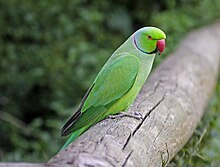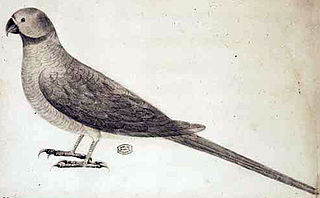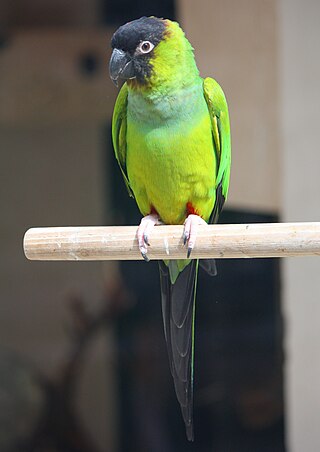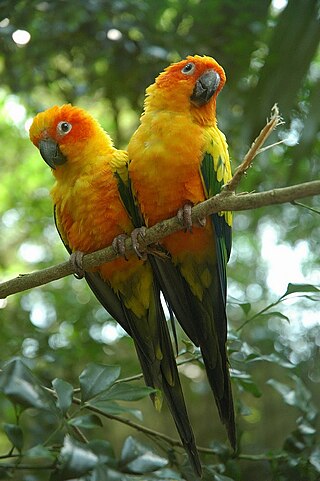This article needs additional citations for verification .(January 2009) |


A parakeet is any one of many small- to medium-sized species of parrot, in multiple genera, that generally has long tail feathers.
This article needs additional citations for verification .(January 2009) |


A parakeet is any one of many small- to medium-sized species of parrot, in multiple genera, that generally has long tail feathers.
The name parakeet is derived from the French word perroquet, which is reflected in some older spellings that are still sometimes encountered, including paroquet or paraquet. However, in modern French, perruche is used to refer to parakeets and similar-sized parrots. [1]
In American English, the word parakeet usually refers to the budgerigar, which is one species of parakeet. [2]

Parakeets comprise about 115 species of birds that are seed-eating parrots of small size, slender build, and long, tapering tails.[ citation needed ] The Australian budgerigar, also known as "budgie", Melopsittacus undulatus, is probably the most common parakeet. It was first described by zoologists in 1891. It is the most popular species of parakeet kept as a pet in North America and Europe.

The term "grass parakeet" (or grasskeet) refers to many small Australian parakeets native to grasslands such as the genus Neophema and the princess parrot. The Australian rosellas are also parakeets. Many of the smaller, long-tailed species of lories may be referred to as "lorikeets". The vernacular name ring-necked parakeet (not to be confused with the Australian ringneck) refers to a species of the genus Psittacula native to Africa and Asia that is popular as a pet and has become feral in many cities outside its natural range.
In aviculture, the term "conure" is used for small to medium-sized parakeets of the genera Aratinga , Pyrrhura , and a few other genera of the tribe Arini, which are mainly endemic to South America. As they are not all from one genus, taxonomists tend to avoid the term. Other South American species commonly called parakeets include the genus Brotogeris parakeets, the monk parakeet, and lineolated parakeets, although lineolateds have short tails.
A larger species may be referred to as "parrot" or "parakeet" interchangeably. For example, "Alexandrine parrot" and "Alexandrine parakeet" are two common names for the same species, Psittacula eupatria, which is one of the largest species normally referred to as a parakeet.
Many different species of parakeets are bred and sold commercially as pets, the budgerigar being the third most popular pet in the world, [3] after cats and dogs.
Parakeets often breed more readily in groups; however, there can be conflicts between breeding pairs and individuals especially if space is limited. The presence of other parakeets encourages a pair to breed, which is why breeding in a group is better. Despite this, many breeders choose to breed in pairs to both avoid conflicts and know offspring's parentage with certainty. Parakeets lay an average of 4-8 eggs, while budgerigars (a species of parakeet) lay an average of 4-6 eggs.[ citation needed ]
As of 2023 [update] , an estimated 10,000 parakeets lived in Brussels, the capital of Belgium. The total made them one of the most populous birds in the city, behind only pigeons and sparrows. [4]
According to a 2018 report, Spanish authorities drew up plans to curb the ever-growing population of parakeets, which reached 30,000 in locations such as Malaga. [5]
In December 2019, Steven Le Comber, of Queen Mary University in London, UK, published an analysis in the Journal of Zoology based on geographic profiling methods. It concluded that the thriving rose-ringed parakeet population in the United Kingdom had grown from numerous small-scale accidental and intentional pet releases. Previous theories had included a pair released by Jimi Hendrix on Carnaby Street and an arrival in 1951 when Humphrey Bogart and Katharine Hepburn visited London with various animals to film The African Queen, set in the equatorial swamps of east Africa. [6] [7]

The budgerigar, also known as the common parakeet, shell parakeet or budgie, is a small, long-tailed, seed-eating parrot. Naturally, the species is green and yellow with black, scalloped markings on the nape, back, and wings. Budgies are bred in captivity with colouring of blues, whites, yellows, greys, and even with small crests. Juveniles and chicks are monomorphic, while adults are told apart by their cere colouring, and their behaviour.

The true parrots are about 350 species of hook-billed, mostly herbivorous birds forming the two superfamilies Psittacidae, and Psittaculidae, two of the three superfamilies in the biological order Psittaciformes (parrots). True parrots are widespread, with species in Mexico, Central and South America, sub-Saharan Africa, India, Southeast Asia, Australia, and eastwards across the Pacific Ocean as far as Polynesia. The true parrots include many of the familiar parrots including macaws, conures, lorikeets, eclectus, Amazon parrots, grey parrot, and budgerigar. Most true parrots are colourful and flighted, with a few notable exceptions.

The rose-ringed parakeet, also known as the ringneck parrot or the Kramer parrot, is a medium-sized parrot in the genus Psittacula, of the family Psittacidae. It has disjunct native ranges in Africa and the Indian Subcontinent, and is now introduced into many other parts of the world where feral populations have established themselves and are bred for the exotic pet trade.

Conures are a diverse, loosely defined group of small to medium-sized parrots. They belong to several genera within a long-tailed group of the New World parrot subfamily Arinae. The term "conure" is used primarily in bird keeping, though it has appeared in some scientific journals. The American Ornithologists' Union uses the generic term parakeet for all species elsewhere called conure, though Joseph Forshaw, a prominent Australian ornithologist, uses conure.

Newton's parakeet, also known as the Rodrigues parakeet or Rodrigues ring-necked parakeet, is an extinct species of parrot that was endemic to the Mascarene island of Rodrigues in the western Indian Ocean. Several of its features diverged from related species, indicating long-term isolation on Rodrigues and subsequent adaptation. The rose-ringed parakeet of the same genus is a close relative and probable ancestor. Newton's parakeet may itself have been ancestral to the endemic parakeets of nearby Mauritius and Réunion.

The Alexandrine parakeet, also known as the Alexandrine parrot, is a medium-sized parrot in the genus Psittacula of the family Psittaculidae, native to South Asia and Southeast Asia. It is named after Alexander the Great, who transported numerous birds from Punjab to various European and Mediterranean countries and regions, where they were prized by the royalty, nobility and warlords.

Psittacula, also known as Afro-Asian ring-necked parrots, is a genus of parrots from Africa and Southeast Asia. It is a widespread group with a clear concentration of species in south Asia, but also with representatives in Africa and the islands of the Indian Ocean. This is the only genus of parrot which has the majority of its species in continental Asia. Of all the extant species only Psittacula calthropae, Psittacula caniceps and Psittacula echo do not have a representative subspecies in any part of mainland continental Asia. The rose-ringed parakeet, Psittacula krameri, is one of the most widely distributed of all parrots.

A companion parrot is a parrot kept as a pet that interacts abundantly with its human counterpart. Generally, most species of parrot can make excellent companions, but must be carefully managed around other common pet species like dogs and cats as they might be hostile towards them.

The echo parakeet is a species of parrot endemic to the Mascarene Islands of Mauritius and formerly Réunion. It is the only living native parrot of the Mascarene Islands; all others have become extinct due to human activity. Two subspecies have been recognised, the extinct Réunion parakeet and the living echo parakeet, sometimes known as the Mauritius parakeet. The relationship between the two populations was historically unclear, but a 2015 DNA study determined them to be subspecies of the same species by comparing the DNA of echo parakeets with a single skin thought to be from a Réunion parakeet, but it has also been suggested they did not constitute different subspecies. As it was named first, the binomial name of the Réunion parakeet is used for the species; the Réunion subspecies thereby became P. eques eques, while the Mauritius subspecies became P. eques echo. Their closest relative was the extinct Newton's parakeet of Rodrigues, and the three are grouped among the subspecies of the rose-ringed parakeet of Asia and Africa.

The long-tailed parakeet or Burung Bayan Nuri in Malay is a parakeet endemic to the regions of Andaman and Nicobar islands, Sumatra, Borneo and Peninsular Malaysia. It is allopatric with the congener, the Red-breasted parakeet, Psittacula alexandri, except in the Andaman islands where they occur together.

The Rodrigues parrot or Leguat's parrot is an extinct species of parrot that was endemic to the Mascarene island of Rodrigues. The species is known from subfossil bones and from mentions in contemporary accounts. It is unclear to which other species it is most closely related, but it is classified as a member of the tribe Psittaculini, along with other Mascarene parrots. The Rodrigues parrot bore similarities to the broad-billed parrot of Mauritius, and may have been related. Two additional species have been assigned to its genus, based on descriptions of parrots from the other Mascarene islands, but their identities and validity have been debated.

The nanday parakeet, also known as the black-hooded parakeet or nanday conure, is a medium-small, mostly green, Neotropical parrot native to continental South America.

The maroon-bellied parakeet is a small parrot found from southeastern Brazil to north-eastern Argentina, including eastern Paraguay and Uruguay. It is also known as the reddish-bellied parakeet, and in aviculture it is usually referred to as the maroon-bellied conure, reddish-bellied conure or brown-eared conure.

A feral parrot is a parrot that has adapted to life in an ecosystem to which it is not native. The birds are often descended from pets that have escaped or been deliberately released. Many species of parrots are highly social, and like to gather in large flocks. Not all feral parrots are able to adapt to life outside of captivity, although having a pre-existing nearby parrot colony can assist with the adaptation process.

The jandaya parakeet or jenday conure is a small Neotropical parrot with green wings and tail, reddish-orange body, yellow head and neck, orange cheeks, and black bill, native to wooded habitats in northeastern Brazil. It is a member of the Aratinga solstitialis complex of parakeets very closely related to, and possibly subspecies of the sun parakeet.

The sun conure, also known as the sun parakeet, is a medium-sized, vibrantly colored parrot native to northeastern South America. The adult male and female are similar in appearance, with black beaks, predominantly golden-yellow plumage, orange-flushed underparts and face, and green and blue-tipped wings and tails. Sun conures are very social birds, typically living in flocks. They form monogamous pairs for reproduction, and nest in palm cavities in the tropics. Sun conures mainly feed on fruits, flowers, berries, blossoms, seeds, nuts, and insects. Conures are commonly bred and kept in aviculture and may live up to 30 years. This species is currently threatened by loss of habitat and trapping for plumage or the pet trade. Sun conures are now listed as endangered by the International Union for Conservation of Nature.

Parrots (Psittaciformes), also known as psittacines, are birds with a strong curved beak, upright stance, and clawed feet. They are conformed by four families that contain roughly 410 species in 101 genera, found mostly in tropical and subtropical regions. The four families are the Psittaculidae, Psittacidae, Cacatuoidea (cockatoos), and Strigopidae. One-third of all parrot species are threatened by extinction, with a higher aggregate extinction risk than any other comparable bird group. Parrots have a generally pantropical distribution with several species inhabiting temperate regions as well. The greatest diversity of parrots is in South America and Australasia.

Birds of Eden is the world's largest free flight aviary and bird sanctuary, located in Kurland village near Plettenberg Bay in the Western Cape, South Africa. The mesh dome of the sanctuary was built over 2.3 hectares of indigenous forest, and is up to 55 metres (180 ft) above ground level. 1.2 kilometres (0.75 mi) of walkways, about 75% of which are elevated, let visitors see the birds at all levels of the aviary.

The Mascarene grey parakeet, Mauritius grey parrot, or Thirioux's grey parrot, is an extinct species of parrot which was endemic to the Mascarene Islands of Mauritius and Réunion in the western Indian Ocean. It has been classified as a member of the tribe Psittaculini, along with other parrots from the Islands.

The monk parakeet, also known as the monk parrot or Quaker parrot, is a species of true parrot in the family Psittacidae. It is a small, bright-green parrot with a greyish breast and greenish-yellow abdomen. Its average lifespan is 20–30 years. It originates from the temperate to subtropical areas of South America. Self-sustaining feral populations occur in many places, mainly in areas of similar climate in North America and Europe.